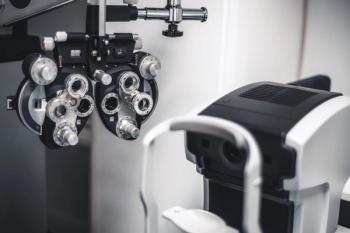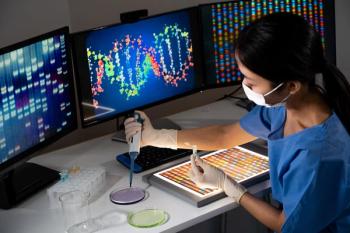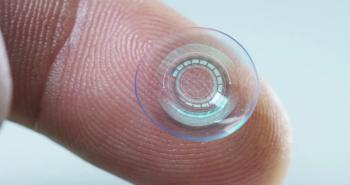
Knowing the science behind spectacle lenses
ODs don't seem to care as much about the science behind spectacle lenses as that of medications and contact lenses. But they should, says Essilor's Howard Purcell, OD, FAAO, and here's why.
Would you prescribe a medication or contact lens without knowing it had gone through extensive research and testing and was approved by the FDA? Probably not. Yet many of us prescribe spectacle lenses to our patients without caring much about the science behind those lenses.
Spectacle lenses are medical devices and are regulated as such in the U.S. Today’s spectacle lenses don’t just provide vision correction, they offer protection from UV rays and help reduce exposure to harmful blue light.1
These advancements are the result of extensive research and development. Step into a spectacle lens research and development facility, and you may be surprised to see significant similarities with pharmaceutical or contact lens R&D facilities, products that most of us know have a lot of science behind them.
In my 10 years with Essilor of America, I’ve learned that there is a great deal of research involved in every lens we manufacture, and I believe it’s important that we as practitioners embrace the science and, when appropriate, share it with our patients.
Related:
Patients need to understand that their spectacle lenses are the result of the same vigorous research, development, and testing as their contact lenses and the medications they take. This is especially true when we are explaining the difference between premium and non-premium lenses. By letting patients know what goes into the lenses they wear every day, we can help ensure they are as informed as possible and minimize the potential for buyer’s remorse.
A multifaceted approach
In addition to the classic approach to research and development, Essilor takes it to the next level. While innovation has always been part of our DNA, we wanted to find a way to ensure that new products and services effectively meet wearer needs today and in the future to enable us to innovate usefully.
We have three Centers for Innovation & Technologies located in Paris, Singapore, and Dallas. At the centers, consumers are divided into groups that allow multidisciplinary teams to better understand wearers’ needs and devise solutions that aim to satisfy all consumers at every stage of their lives. The teams listen to consumers to learn about their lifestyles and what is important to them. In Dallas, we also have a lab where engineers use 3D printers to create prototypes of lenses and other concepts that result from our consumer-based research.
Virtual reality testing is another element of how we bring lenses to market. Essilor R&D teams have used virtual reality simulators for many years to test new designs through immersing wearers in a 3D virtual world. It has accelerated innovation, making it possible to identify the best lens designs more quickly without the need for initial prototyping.
Related:
Essilor also understands the value and benefit of collaboration with entities outside of the company. To that end, we have established a scientific, technological and academic ecosystem of long-term partnerships with more than 20 universities and public research organizations around the world, including Paris Vision Institute, Le Centre National de la Recherche Scientifique (The National Center for Scientific Research, Paris; CNRS), Ãcole Polytechnique of Montréal, and Shanghai and Wenzhou universities in China. These efforts add up to more than 500 researchers around the world and an R&D investment of more than $200 million annually.
The union of science and innovation
A recent example of how Essilor’s research and development processes work together to create a spectacle lens is the new Varilux X Series progressive lens.
Eyecare professionals know that progressive lens wearers can struggle to find “just the right spot” when shifting among near, mid- and far-range objects. A survey2 of premium progressive wearers found that 50 percent are not completely satisfied with their intermediate and near vision. That’s when R&D steps in.
The newest Varilux product is the result of five years of research and development, including 19 wearer studies with more than 2,700 subjects.2 As part of wearer testing, Essilor created HouseLab, a controlled real-home environment that immerses wearers in a natural but controlled environment to observe their experiences as wearers test the lenses in distance and near-vision activities.
Demand the science
Optometrists should demand the same level of science in spectacle lenses we prescribe as we do from contact lenses or pharmaceuticals. The more we learn, the better we can serve our patients. It is our responsibility to give our patients the best vision possible. By continuing to invest in innovation through rigorous research and development, together we will achieve that goal.
Related:
References
1. Arnault E, Barrau C, Nanteau C, Gondouin P, Bigot K, Viénot F, Gutman E, Fontaine V, Villette T, Cohen-Tannoudji D, Sahel JA, Picaud S. Phototoxic action spectrum on a retinal pigment epithelium model of age-related macular degeneration exposed to sunlight normalized conditions. PLoS One. 2013 Aug 23;8(8):e71398.
2. Fricker S, Hernandez-Castaneda M, Heslouis M, Jolivet V, Lebrun C, Paillé D, Rousseau, B. Varilux X Series Lenses: Extended Ranges of Vision. Available at: http://www.pointsdevue.com/sites/default/files/varilux_x_extended-ranges-of-vision-white_paper_0.pdf?utm_source=Website&utm_campaign=Varilux%20X%20series%20Extended&utm_content=GB. Accessed 2/26/18.
Newsletter
Want more insights like this? Subscribe to Optometry Times and get clinical pearls and practice tips delivered straight to your inbox.















































